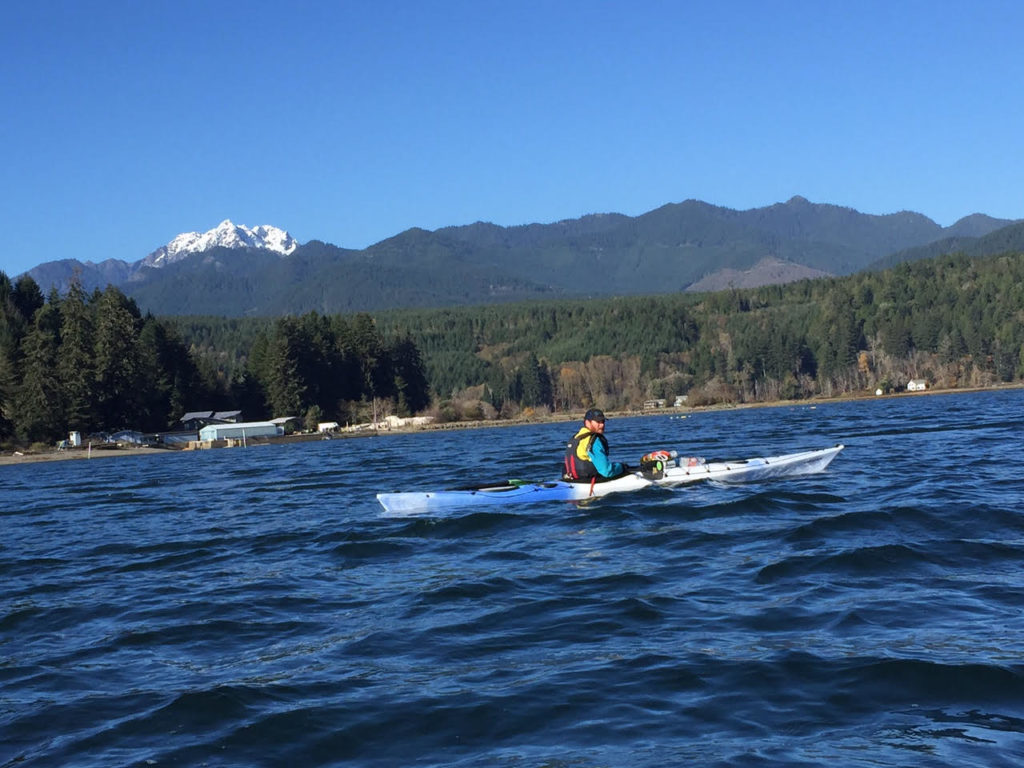
Launch
It was still dark outside when my friend Jarrett and I lifted two heavily-loaded kayaks onto the kayak rack had just built onto the roof of his weathered white pickup.
We had cinched the boats down tight with cam-straps and shaken them vigorously in their place to make sure they were immobile. We drove past the streets of Port Angeles under heavy rain. It was the kind of weather that doesn’t exactly make one eager for three days of exposed paddling, followed by nights cramped nights in a tent, where a few cups of moisture could mean the difference between comfort and misery.
Over those three days, we would paddle north for almost 60 miles of the Hood Canal, a salt water arm of Puget Sound.
November paddling. In a rainy part of the country.
We had packed for the wet, but knew that damp and cold were talented at evading the defenses we put up for them. We had gathered drysuits, windbreakers, miscellaneous and sundry camping items. We stuffed the gear into the narrow dry bags we would need to fit them in our kayaks. There were pounds of food that we’d use to keep our caloric furnaces in order.
Now they were very heavy kayaks that threatened to crush us when we lifted them.
We moved slow that morning stockpiling heat from cups of coffee. Killing time comes very naturally when you have reservations about starting a trip.
I drove behind the truck in my Civic, street lamps and neon flashing back at me from the rain-slick pavement. Gradually, the gray illumination spilled out of the east. It was a soggy cardboard sky. A scraggly remainder of ochre leaves rattled on skeletal roadside trees.
As the wind picked up, Jarrett stopped so that we could get reinforce the kayak straps. The wind whipped at the trees as we went about lashing down the boats. It felt like gale force conditions.
“Are you sure we should be paddling out in this kind of weather?” Jarrett asked.
I considered. The conditions did look perilous, but we were still close to a hundred miles away from the boat launch where it might be a different story. Having spent a whole day planning and packing, the idea of turning back left a bad taste in my mouth.
We pressed on, and in another forty minutes or so, we came to the takeout point at Quilcene Bay where there was the same strong, southerly wind that we’d encountered when we’d stopped to fix the boats. Mean whitecaps were curling over the agitated water. The good news was that they were going in the direction we would be traveling. I parked my car and got in the truck with Jarrett. Hopefully, we would be back in this place in three days at the end of a successful journey.
Ice age glaciers up to 3,500 feet deep, carved out the complicated network of channels and islands west of Seattl, including the Strait of Juan de Fuca, Puget Sound and Hood Canal, which makes up Puget Sound’s westernmost arm with the Olympic Mountains rising up on the other side. If the glacier had carved a couple more miles to the east, it would have joined the Sound and turned the Kitsap Penninsula into an island we could boat around.
The Canal channels both wind and tides. Jarrett and I expected to make our best time paddling in the mornings when the tides were going out and the current was with us. The Canal also has a strong tendency for southerly winds however, and this was also in our favor.

When we got to the Belfair State Park at the end of the canal, the high tide spared us the effort of carrying our boats out onto mudflats.
Next to us was Big Mission Creek, which came in running swift from the heavy rains. October had been a record month for much of Western Washington. In nearby Olympia, there had been 12.4 inches of rain, compared to the average of 4.6 inches for that month.*
I watched a dark form thrash in the current, dorsal fin skittering above the water. It was trying to go upstream, but the current was too much. I saw the salmon fight its way higher where the water moved fast over loose gravel, then it gave up and let the current take it back down toward the salt water. Perhaps it would find another route. As I gazed around the pool, I saw other salmon sitting in the water, fighting the current now and then. None of them seemed to have much luck. A few scattered carcasses lay beached on the rocks. Hopefully, they had spawned already, but I wondered if the unusually high current had prevented them from getting where they needed to.
Our kayak journey looked like it would be less perilous then what the salmon had to deal with. The winds had miraculously stilled and the start of the Hood Canal looked glassy. The rains had diminished, although heavy clouds to the west promised more to come. The main challenge was hauling the heavily-loaded boats to the water. Then we had about 15 miles ahead of us to Potlatch Campground where we would stop for the night.
This section of the canal was just over a mile wide. We would be heading west all day, until we reached our campground at The Great Bend, where the Skokomish River comes in. There, the canal goes north and whither would go the kayakers.
The loaded boats handled differently in the water from what we were used to; they were slower and more reluctant to turn. Jarrett found his boat had a tendency to drift to the left for some reason and had to paddle harder on that side.
I was grateful for the skeg, basically a fin that drops down, which made the boat easier to stay on course. If I wanted to grab a water bottle off my deck or mess with some equipment, I could paddle hard for a second and then let myself drift, so that I was still making progress, even when I wasn’t paddling.
The outgoing tide, gave more oomph to out paddle strokes.
When we paddled hard, we got warm. The fleeces we wore under our drysuits were definitely overkill. If we broke a sweat, it would mean dealing with moist, clammy clothes, likely for the rest of the trip.
The water was a tannic brown like well-steeped tea, very different from the clear, cold water I was used to guiding on the Strait not far away. Neither were there the large clumps of bull kelp of Pacific giant kelp that flourish in that rougher, rockier water. In shallow spots, I could look down at the sand, and see the white blobs of oysters growing there, another critter that I don’t see when I paddle on the Strait.
Various diving birds populated the water surface, including merganser ducks, murres and grebes the size of geese
“Hey check it out, in that tree!” Jarrett shouted. There were two bald eagles watching us.
When we took a break at a state park, all the heat we had been saving up seemed to disappear. I threw on my balaclava for extra warmth, and we paced around eating sandwiches in the drizzle.
It was good to get moving again and get the warmth back. Soon I was dipping my hat in the water to cool off and was grateful when it started pouring.
Now and then, a small black head would pop out of the water and a harbor seal would regard us with curious eyes.
We made one more stop at the town of Union, before we crossed the large bay at the mouth of the Skokomish River, which is none for a massive salmon run. Though, we didn’t explore the river mouth itself, we likely would have encountered droves of salmon, and the nets that the Skokomish Tribe sets up to catch them.
The veil of clouds began to break in the west, revealing the jagged faces of the Olympic Mountains. Mighty snowfields looked down at us from the high ridges.
As if to herald this vision, the mournful cry of loons called out from in front of us, seemed to embody the essence of that powerful place.
Croaking Salmon
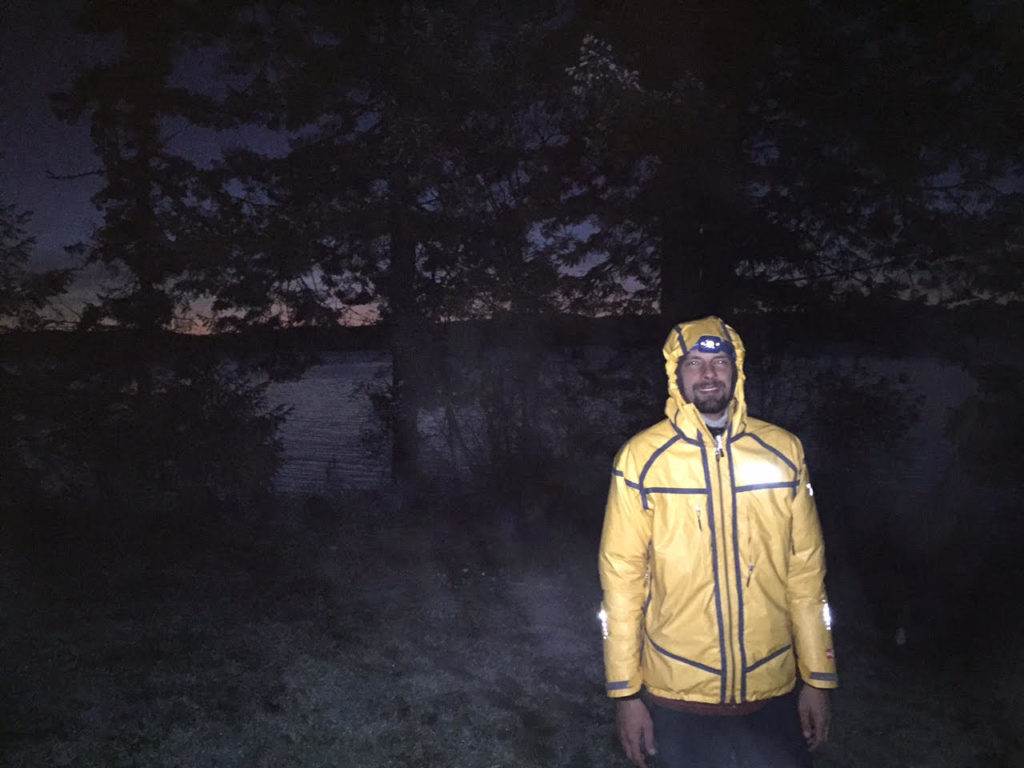
The Potlatch Campground was in the midst of a construction project, which meant that it took a moment to find the proper place to set up shelter.
It is worth mentioning that the we camped both nights of our trip on places made possible by the Washington Water Trails Association, which laid out the Cascadia Marine Trail from southern Puget Sound up to Canada and with a connector into Hood Canal. If there had been more time, the paddler-specific campsites along this trail would have given us many options for camping and adventuring in the region.
A small stream flowed through a human-dug drainage nearby. Dozens of flopping, struggling salmon thrashed there way over the shallow water. Several of the fish were stopped at one of the many logs lying in the ditch. Others were almost completely out of the water. lying seemingly dead, and then bursting into a frenzy of flapping effort that gained them an inch or two of progress, if any. I watched their beaked mouths, monstrous, opening and closing as if trying to take in the air they couldn’t breathe. Their sides looked bruised, even actively bleeding from the effort of going upstream.
I walked further and further up the ditch, only to find more and more salmon that had somehow flopped their way up. Were they spawning successfully? Or was the drainage ditch only a cruel trick that led them to their doom? Of course all of the salmon would die, whether they reproduced or not. Same is true of humans, I suppose.
Bearing witness to the Amazing Cycle of Life was not getting our camp set up any faster. I helped Jarrett rig up the rainfly that we would sleep under and got to work cooking dinner beneath the handy pavilion nearby. It was nice having a dry place to eat when the rain started falling again.
There was no break in the precipitation that night. The staccato drops made a constant din on the outside of the rainfly. Thankfully, the soil where we had set up was loose and drained easily. We didn’t have to worry about it puddling up on us.
I had a couple of damp clothes items in my sleeping bag with me to dry them out for the morning, though this made sleeping far less pleasant.
“I hate sleeping in damp bags,” I muttered.
“Really? I’m completely dry in here,” Jarrett said, thwarting my attempt to give my misery some company.
Every now and then I heard splashing from the salmon in the ditch. There was also a low croaking sound from the same direction. I pictured those beaked mouths that I had seen in the stream earlier, opening and closing, opening and closing.
“The salmon are coming out of the water to eat us,” I announced.
When morning came, there was a dim glow on the horizon, and the sky appeared cloudless.
“Man! How about those salmon croaking last night?” Jarrett said.
“Oh yeah. That’s so weird. I had no idea they did that.”
I tried to make the sound.
“Eyeaghhhhh!”
“Aaaaggghhh!” Jarrett said.
“That’s going to be the rallying call for this trip,” I said. “You know, when the going gets tough. We’ve got to think like these salmon. Eyaaaggghhhh!”
We ate a bunch of oatmeal mixed with coconut butter as a pick me up.
As the sun rose, we set up gear to dry.
A couple of state employees came over to the stream to monitor the salmon. We found out that the state had dug the ditch for the salmon, who hadn’t been able to use the stream before.
Though the fish didn’t seem like they were having much luck to my untrained eye, apparently they had been getting far upstream, and even when they didn’t, many still had still found room to spawn successfully. After the spawn had grown up in the ocean, they too would return to this place.
“We could hear them flopping around last night, even croaking,” Jarrett said.
The workers seemed surprised to hear salmon that salmon croaked, but we told them all about it.
So far, the stream mitigation work had been successful enough that members of the Skokomish Tribe had set up nets near the mouth of the stream. It was also a popular spot for seals, which had a taste for the fish. A group of seals were on a raft nearby, lounging in the sun. It was only after the workers left that we heard the seals start talking to each other.
“Eyaghhh!”
“Uhnnn!”
It looked like we had mistaken the sounds of the seals on the raft for salmon in the stream. Rookie mistake.
The Close Encounter
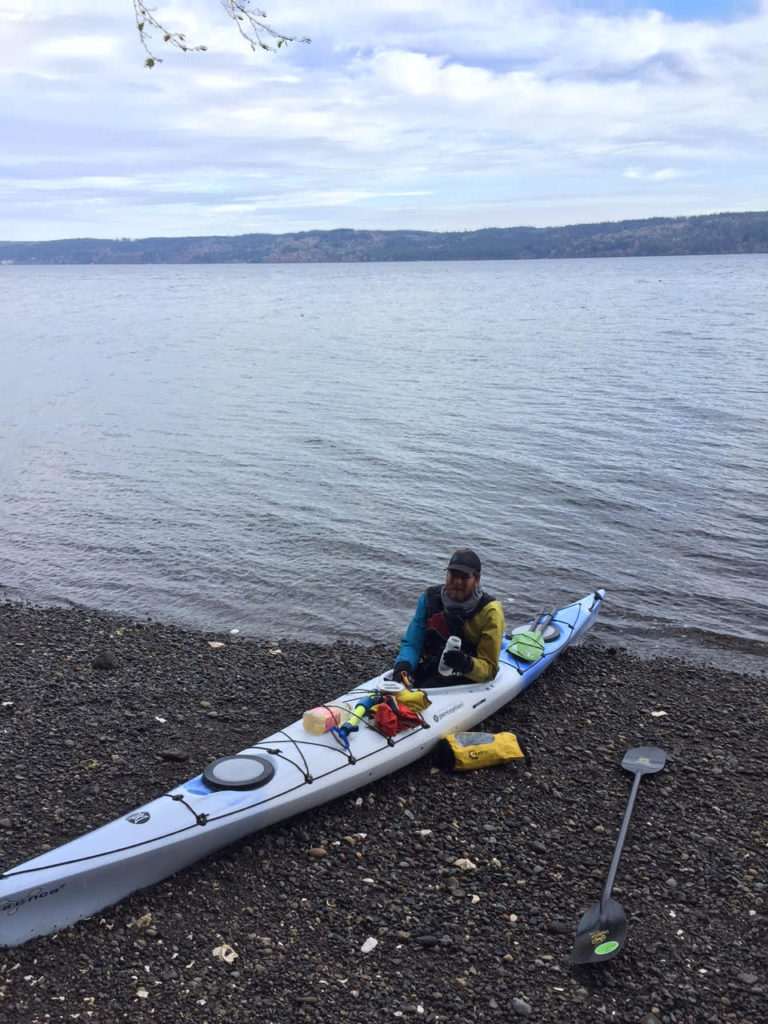
Drying clothes and talking gave us a late start onto the water. We aimed far out into the canal to take the best advantage of the tidal current and a light southerly wind. Under the full sun, we’d traded out the warm fleeces we’d worn the day before for thinner synthetic layers. Now we could see several of the Olympic Mountains in sunny relief, including The Brothers and Ellinor.
We were about a mile offshore when we decided to raft up and take a break. I was eating some peanuts when I heard a sharp exhale from the water next to us.
I almost choked.
A massive sea lion head was poking up looking at me. Maybe it was 20 feet away. The head popped back down. At a glance, the sea lion was easily over 500 pounds, though maybe a lot more than that. Male Stellar sea lions can push 2,500. They can get much heavier than that, to basically the size of grizzly bears. While they are not necessarily as ornery as grizzlies, I’ve heard these sea lions can be pushy, including accounts of them grabbing hold of divers’ fins. * I’ve had one of them swim alongside me for a couple minutes, snorting and merging closer to the point that I slapped the water with my paddle to ward it off.
We floated for a while longer, and the head came up next to us again.
“Pffffft!”
The sea lion breathed out. It gazed at us with large dark eyes.
Was it pissed with us or was I just projecting? Did I want to know for sure?
The head went down again.
A few moments later, it popped up again.
“Pfffffft!”
“OK, I’m about ready to take off now,” I said.
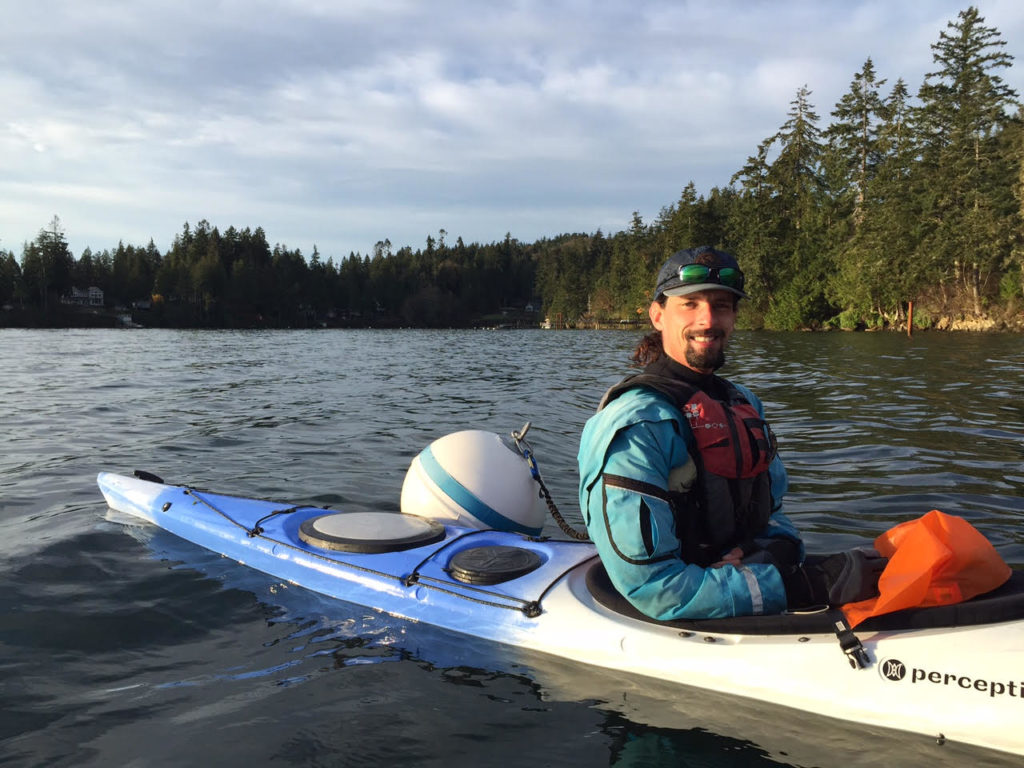
We made good progress on the way to our camp at Triton Cove, in large part because of the current moving with us. I avoided taking an onshore bathroom break by way of a challenging maneuver, leaning my boat with Jarrett grabbing onto back deck. If the waves had been tall, it probably would have been a no go, but it turned out to be more convenient than using a bottle or adding a mile and a half to the trip distance. Learning new skills is part of the reason for adventure if you ask me.
In the miles before camp, we enjoyed views of Glacier Peak and Mount Baker in the Cascades to the north of us.
We ended at a boat ramp where we unloaded our kayaks and then hauled them up to a grassy campsite. It was just after 3 p.m., but the sun was already low in the sky. We took advantage of the light that was left to set up a clothes line to dry some of the clothes and gear.
While the sun set, we heard the sound of seals croaking from the water nearby. It was still cool, even if we had mistaken the same sound for salmon earlier. Eventually, the western light faded and the stars began to glimmer. Illumination from the distant cities of Seattle and Tacoma blobbed over the east like a false sunrise. The night brought dew as well. I felt some clothes on the line, and realized that they were already getting damp. Should have caught that earlier.
I through everything inside our shelter, packed my drysuit away in a kayak hatch. At least, knowing that there was only one day to go, I didn’t have to be so worried about damp layers, provided I had a spare in reserve.
The Last Day
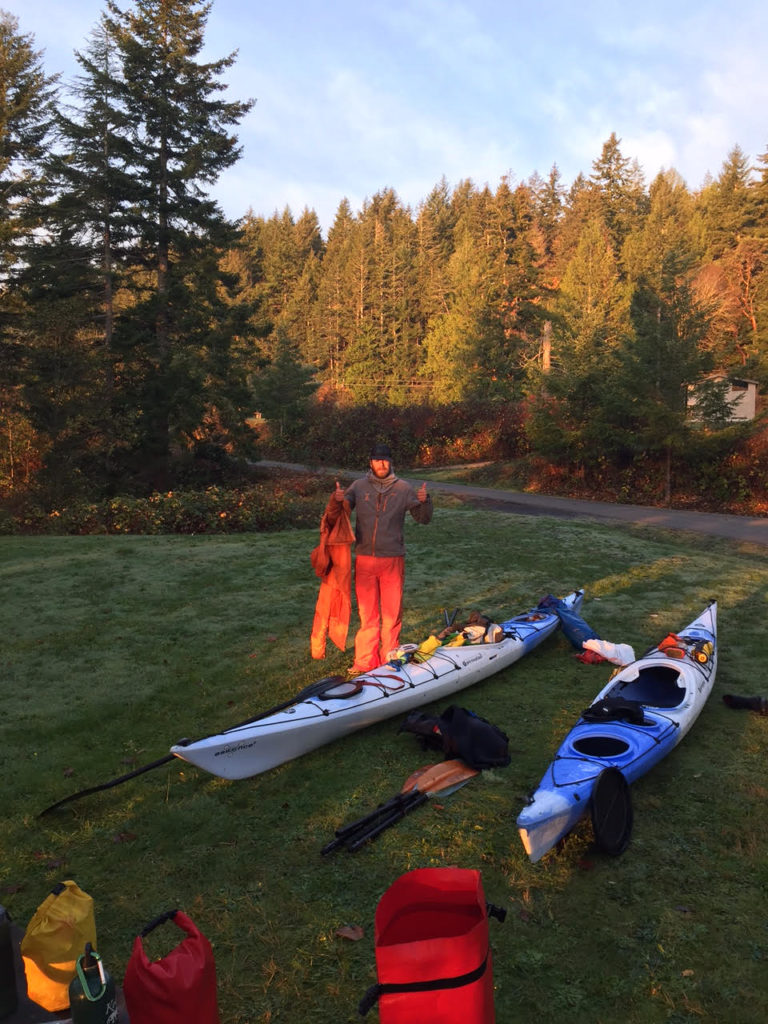
The night saw plenty of moisture accumulate beneath the rainfly, despite our best efforts to ventilate. The clear skies had made the morning that much colder, and the motivation to get out of our sleeping bags that much harder to summon.
We were out of the tent by 6:45 and I walked by headlamp to a nearby stream where I filled up water to start breakfast. The sun rose with a fiery corridor reflected over the Hood Canal. Warmth began to find us. Still, we didn’t take the time to hang stuff up the way that we had the previous morning. We were hot to get moving.
By the time we’d eaten, taken down the shelter, organized gears loaded everything into the hatches, put on drysuits and hauled the boats to the water, it was nine o’clock. We had the favorable current and some tailwind. Once again, we took far out into the canal, where we could see snowy peaks towering above us to the west, and the even larger Mount Baker and Glacier Peak rising up in front of us.
Briefly, for a few minutes only, I caught sight of the Great Grand Daddy of the Cascades: Mount Ranier. It always appears dreamlike to me and I struggle to tell myself that the thousands of feet of snow and ice there are real things, part of the same reality below where there were trees, parking lots, wet sand.
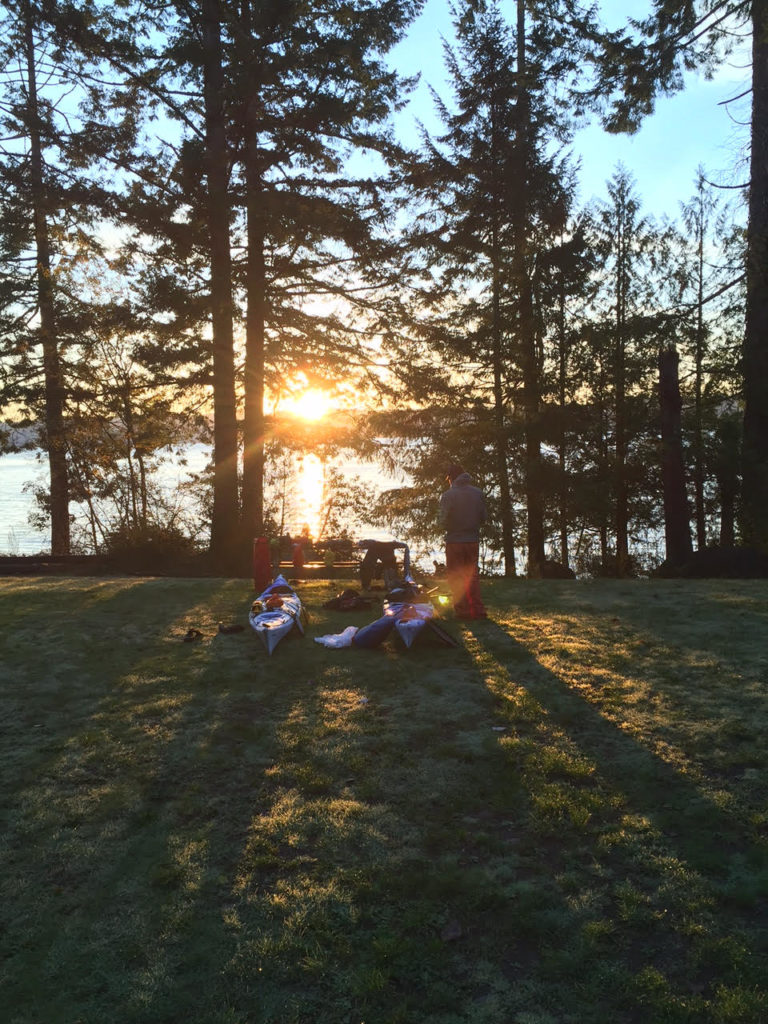
Things were getting more interesting on the water, as the clouds began to fill the sky and a tailwind began kicking up two-foot waves. I caught some great surf rides, using the skeg to keep on track.
We pulled onto a marshy spit where we replenished with food. Jarrett unpeeled the top of his drysuit to put a fleece on. I decided that even though it had gotten a little cooler, a balaclava would be sufficient to keep me toasty. Sure enough, after we started paddling, the sun came back out. Soon Jarrett was roasting with his warm layer on but with no quick way to change clothes. I flipped my balaclava down and commented on how wonderful I felt.
We went by the Dosewallips river drainage, where we saw two bald eagles and at least a dozen harbor seals. They were, no doubt, gorging on the migrating salmon. I felt a greater understanding for why so many Northwesterners, including native tribes, express such reverence for the fish, seeing firsthand how much depends upon their bounty.
We took a break in a nearby marsh so Jarrett could utilize the bounty of a convenience store in nearby Brinnon. I entertained myself by exploring a nearby culvert, too low to paddle through unless I sunk deep inside my cockpit. I handed my way up along the ceiling to the other side of 101, where the marsh came up against some farmland. Going back out was more fun since I had the tidal current going with me and sped through the dark passage like a torpedo — banging up against walls occasionally.
Jarrett and I snacked in the full sun, watching the marsh birds flit to and fro. He decided to ditch the fleece he’d put on earlier for our last push to Quilcene. It was clear that we were making great time. The fact that the wind was picking up from the south was just another bonus.
We sped away from the marsh and then across the water to a large point. The waves gifted me with many a surf ride. The Hood Canal forked in front of us. To the east went out toward the Strait of Juan de Fuca and the San Juan Islands; West lay Dabob Bay and, off of that, Quilcene Bay where my car was parked.
Fourteen knot winds pushed us along at a fast clip, with more assistance from the waves. It wasn’t long before we pulled into the Quilcene Marina: the end of our ride. We paddled in so that our boats hit the ramp at the same time, bumped fists.
Compared to what the salmon were doing, we had had an easy time of it, moving with the elements instead of against. It was also easier than carrying the stuff that we’d brought out on our backs as we would have on a hiking trip, The hardest part was managing the gear rodeo so we kept our stuff dry. There had been no massive waves, nor punishing gales, but their had been time to chill, tp contemplate the beauty of the mountains, the beauty of the water and the uniqueness of some of the creatures that made this place their home,
“Great trip, Man,” Jarrett said.
“Great trip,” I agreed.
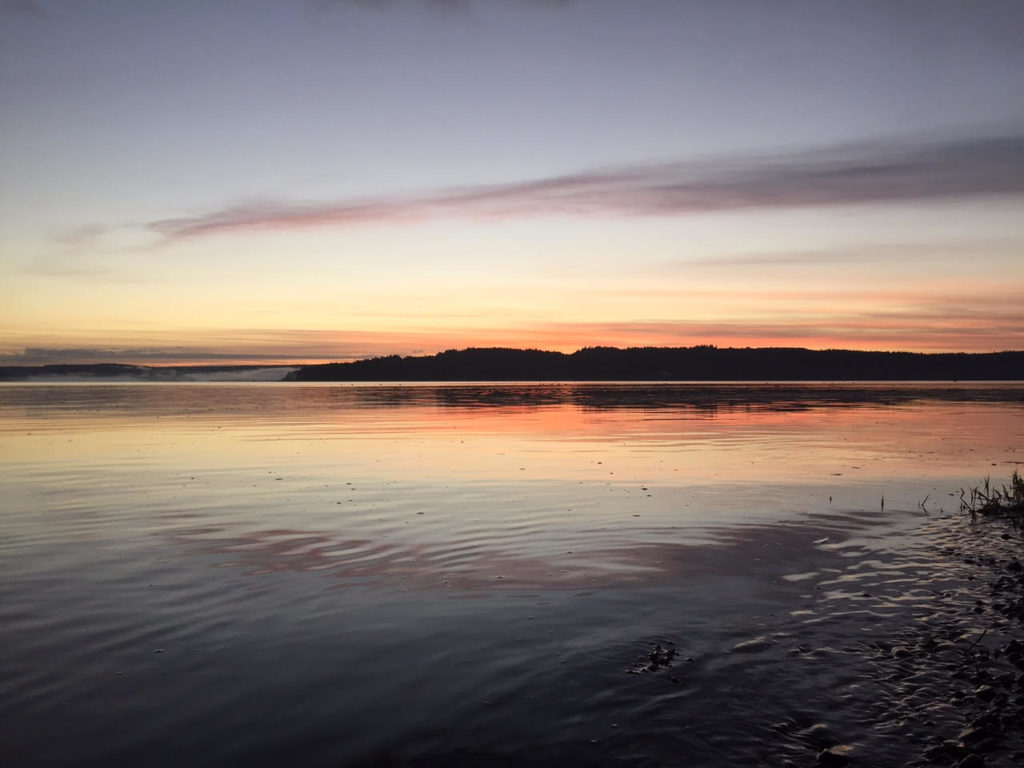
Notes:
*http://www.usclimatedata.com/climate/olympia/washington/united-states/uswa0318/2016/10 and http://q13fox.com/2016/10/26/soggy-nw-on-verge-of-breaking-october-rainfall-records/
** http://www.marinemammalcenter.org/education/marine-mammal-information/pinnipeds/steller-sea-lion/
